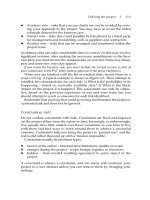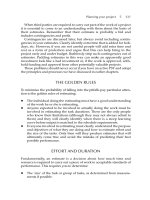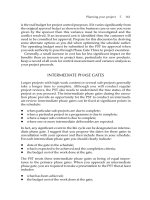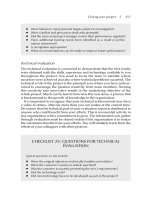Management a practical introduction 3rd kinicky chapter 05
Bạn đang xem bản rút gọn của tài liệu. Xem và tải ngay bản đầy đủ của tài liệu tại đây (518.49 KB, 49 trang )
Management
A Practical Introduction
Third Edition
Angelo Kinicki &
Brian K. Williams
Kinicki/Williams, Management: A Practical Introduction 3e ©2008, McGraw-Hill/Irwin
Chapter 5: Planning
The Foundation of Successful
Management
Planning & Uncertainty
Fundamentals of Planning
The Planning/Control Cycle
Management by Objectives
Project Planning
Kinicki/Williams, Management: A Practical Introduction 3e ©2008, McGraw-Hill/Irwin
5.1 Planning & Uncertainty
HOW CAN PLANNING HELP MANAGERS DEAL
WITH UNCERTAINTY?
Planning: defined as
setting goals and
deciding how to achieve
them
Another definition:
Planning is coping with
uncertainty by
formulating future
courses of action to
achieve specified results.
Kinicki/Williams, Management: A Practical Introduction 3e ©2008, McGraw-Hill/Irwin
5.1 Planning & Uncertainty
HOW CAN PLANNING HELP MANAGERS DEAL
WITH UNCERTAINTY?
Planning is used together with strategic management
and evolves from the company’s mission and vision
Planning covers strategic planning (done by top
managers, tactical planning (done by middle managers),
and operational planning (done by first-line managers)
Kinicki/Williams, Management: A Practical Introduction 3e ©2008, McGraw-Hill/Irwin
5.1 Planning & Uncertainty
Figure 5.1: Planning and Strategic Management
Kinicki/Williams, Management: A Practical Introduction 3e ©2008, McGraw-Hill/Irwin
5.1 Planning & Uncertainty
WHY NOT PLAN?
Managers need to be cautious when planning for
two reasons:
1. Planning requires managers to set aside their
regular responsibilities to develop plans
2. Managers need to be flexible enough to react
to new events because there may not always be
enough time to plan
Kinicki/Williams, Management: A Practical Introduction 3e ©2008, McGraw-Hill/Irwin
5.1 Planning & Uncertainty
HOW DOES PLANNING HELP?
There are four main benefits of planning:
1. Organizations can use plans to check their
progress toward their goals
2. Plans define the responsibilities of a firm’s
departments and coordinates their activities
3. Planning requires managers to consider what
may happen in the future
4. Planning for unpleasant contingencies helps
managers deal with uncertainty
Kinicki/Williams, Management: A Practical Introduction 3e ©2008, McGraw-Hill/Irwin
Why not plan?
Planning requires you to set
aside time to do it
Most managers are time-starved
Hard to set aside time to plan
You may have to make some
decisions without a lot of time
to plan
Even in today’s computer age, you
may not have time to plan a
decision
Plan need not be perfect to be
executable
McGraw-Hill/Irwin
Kinicki/Williams, Management: A Practical Introduction
3eMcGraw-Hill
©2008, McGraw-Hill/Irwin
© 2006 The
Companies, Inc. All rights reserved.
The Benefits of Planning
1)
Planning helps you check on your progress
2)
Planning helps you coordinate activities
3)
Planning helps you think ahead
4)
Above all, planning helps you cope with uncertainty
McGraw-Hill/Irwin
Kinicki/Williams, Management: A Practical Introduction
3eMcGraw-Hill
©2008, McGraw-Hill/Irwin
© 2006 The
Companies, Inc. All rights reserved.
5.1 Planning & Uncertainty
There are three types of uncertainty:
1. State Uncertainty
2. Effect Uncertainty
3. Response Uncertainty
Kinicki/Williams, Management: A Practical Introduction 3e ©2008, McGraw-Hill/Irwin
Three Types of Uncertainty
“What possible harmful event could occur?”
State Uncertainty: when the environment
is considered unpredictable.
Example: the uncertainty regarding the
weather
McGraw-Hill/Irwin
Kinicki/Williams, Management: A Practical Introduction
3eMcGraw-Hill
©2008, McGraw-Hill/Irwin
© 2006 The
Companies, Inc. All rights reserved.
Three Types of Uncertainty
“What possible harmful impact might an
environmental change have?”
Effect Uncertainty: when the effects of
environmental changes are unpredictable.
Example: losing the trail in a snowstorm and
risking hypothermia.
McGraw-Hill/Irwin
Kinicki/Williams, Management: A Practical Introduction
3eMcGraw-Hill
©2008, McGraw-Hill/Irwin
© 2006 The
Companies, Inc. All rights reserved.
Three Types of Uncertainty
“What possible harmful consequence
might a decision have?”
Response Uncertainty: when the
consequences of a decision are uncertain.
Example: you might have a cell phone in a
snowstorm, but someone has to receive
the call.
McGraw-Hill/Irwin
Kinicki/Williams, Management: A Practical Introduction
3eMcGraw-Hill
©2008, McGraw-Hill/Irwin
© 2006 The
Companies, Inc. All rights reserved.
Chapter 5: Planning
CLASSROOM PERFORMANCE SYSTEM
A firm that is analyzing what possible harmful
event could occur is looking at
A) response uncertainty
B) effect uncertainty
C) defense uncertainty
D) state uncertainty
Kinicki/Williams, Management: A Practical Introduction 3e ©2008, McGraw-Hill/Irwin
Chapter 5: Planning
CLASSROOM PERFORMANCE SYSTEM
A firm that is analyzing what possible harmful
event could occur is looking at
A) response uncertainty
B) effect uncertainty
C) defense uncertainty
D) state uncertainty
Kinicki/Williams, Management: A Practical Introduction 3e ©2008, McGraw-Hill/Irwin
5.1 Planning & Uncertainty
Raymond E. Miles and Charles C. Snow
suggested that firms will adopt one of four
strategies to respond to uncertainty:
1. Defenders
2. Prospectors
3. Analyzers
4. Reactors
Kinicki/Williams, Management: A Practical Introduction 3e ©2008, McGraw-Hill/Irwin
Responding to Uncertainty
Defenders: are expert
at producing and
selling narrowly
defined products and
services.
Prospectors: focus
on developing new
markets or services
and in seeking out new
markets rather than
waiting for things to
happen.
McGraw-Hill/Irwin
Analyzers: let the other
organizations take the risks
of product development and
marketing and then imitate
what seems to work best.
Reactors: make
adjustments only when
finally forced to by
environmental
pressures.
Kinicki/Williams, Management: A Practical Introduction
3eMcGraw-Hill
©2008, McGraw-Hill/Irwin
© 2006 The
Companies, Inc. All rights reserved.
5.1 Planning & Uncertainty
Miles and Snow also argued that firms
continuously make decisions about three kinds
of business problems:
1. entrepreneurial - selecting and making
adjustments of products and markets
2. engineering - producing and delivering the
products
3. administrative - establishing roles,
relationships, and organizational processes
Kinicki/Williams, Management: A Practical Introduction 3e ©2008, McGraw-Hill/Irwin
5.2 Fundamentals Of Planning
WHAT IS INVOLVED WITH PLANNING?
Planning translates an organization’s mission
(purpose or reason for being) into objectives
The mission statement answers the question
“what is our reason for being?”
The vision statement answers the questions
“what do we want to become where do we want
to go strategically?”
Planning begins with the mission statement
Kinicki/Williams, Management: A Practical Introduction 3e ©2008, McGraw-Hill/Irwin
Mission Statement
Outline of the fundamental purposes of the
organization
Should address:
Organization’s self-concept
Company philosophy and goals
Long-term survival
Customer needs
Social responsibility
Nature of company’s product or service
McGraw-Hill/Irwin
Kinicki/Williams, Management: A Practical Introduction
3eMcGraw-Hill
©2008, McGraw-Hill/Irwin
© 2006 The
Companies, Inc. All rights reserved.
The World Bank’s Mission
1)
In the last chapter, we learned about the World Bank.
2)
Go to
3)
Explore the “about us” section
4)
What is the World Bank’s mission?
5)
Does this mission statement meet the criterion laid
out in this chapter?
McGraw-Hill/Irwin
Kinicki/Williams, Management: A Practical Introduction
3eMcGraw-Hill
©2008, McGraw-Hill/Irwin
© 2006 The
Companies, Inc. All rights reserved.
5.2 Fundamentals Of Planning
Figure 5.2: Making Plans
Kinicki/Williams, Management: A Practical Introduction 3e ©2008, McGraw-Hill/Irwin
5.2 Fundamentals Of Planning
Having clearly defined mission and vision
statements allows three things to happen:
1. strategic planning by top management where
long-term goals are determined and available
resources are identified
2. tactical planning by middle management where
contributions their departments or similar work
units can make are determined
3. operational planning by first-line managers
where how specific tasks will be accomplished
using available resources is determined
Kinicki/Williams, Management: A Practical Introduction 3e ©2008, McGraw-Hill/Irwin
Types of Planning
Strategic planning: top managers
decide what the organization’s longterm goals should be for the next 15 years with the resources they
expect to have available.
Tactical planning: middle managers
decide what contributions their
departments or similar work units
can make with their given resources
during the next 6-24 months.
Operational planning: first-line
managers determine how to
accomplish specific tasks with
available resources within the next
1-52 weeks.
McGraw-Hill/Irwin
Kinicki/Williams, Management: A Practical Introduction
3eMcGraw-Hill
©2008, McGraw-Hill/Irwin
© 2006 The
Companies, Inc. All rights reserved.
5.2 Fundamentals Of Planning
Figure 5.3: Three Levels of Management, Three
Types of Planning
Kinicki/Williams, Management: A Practical Introduction 3e ©2008, McGraw-Hill/Irwin









